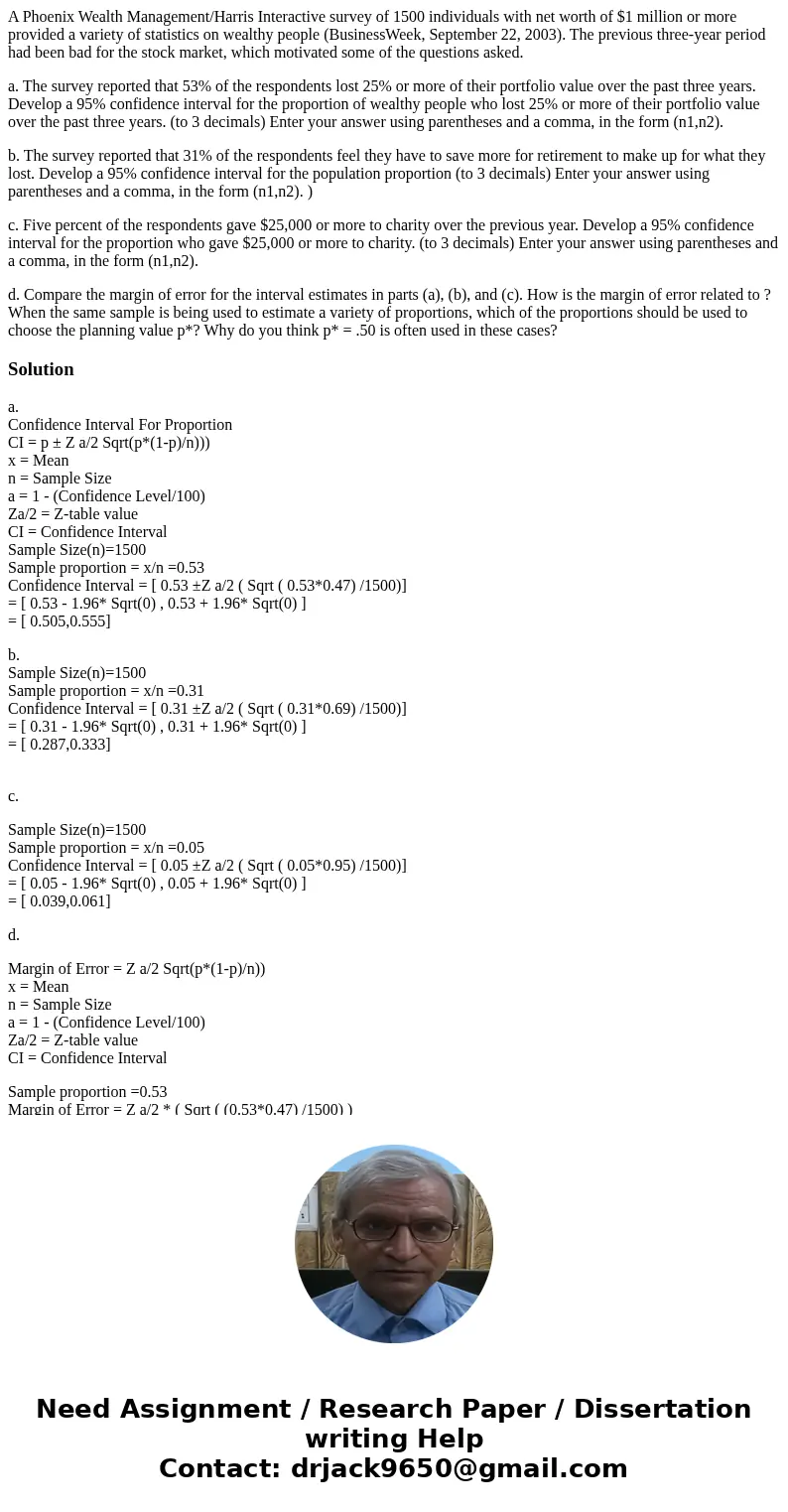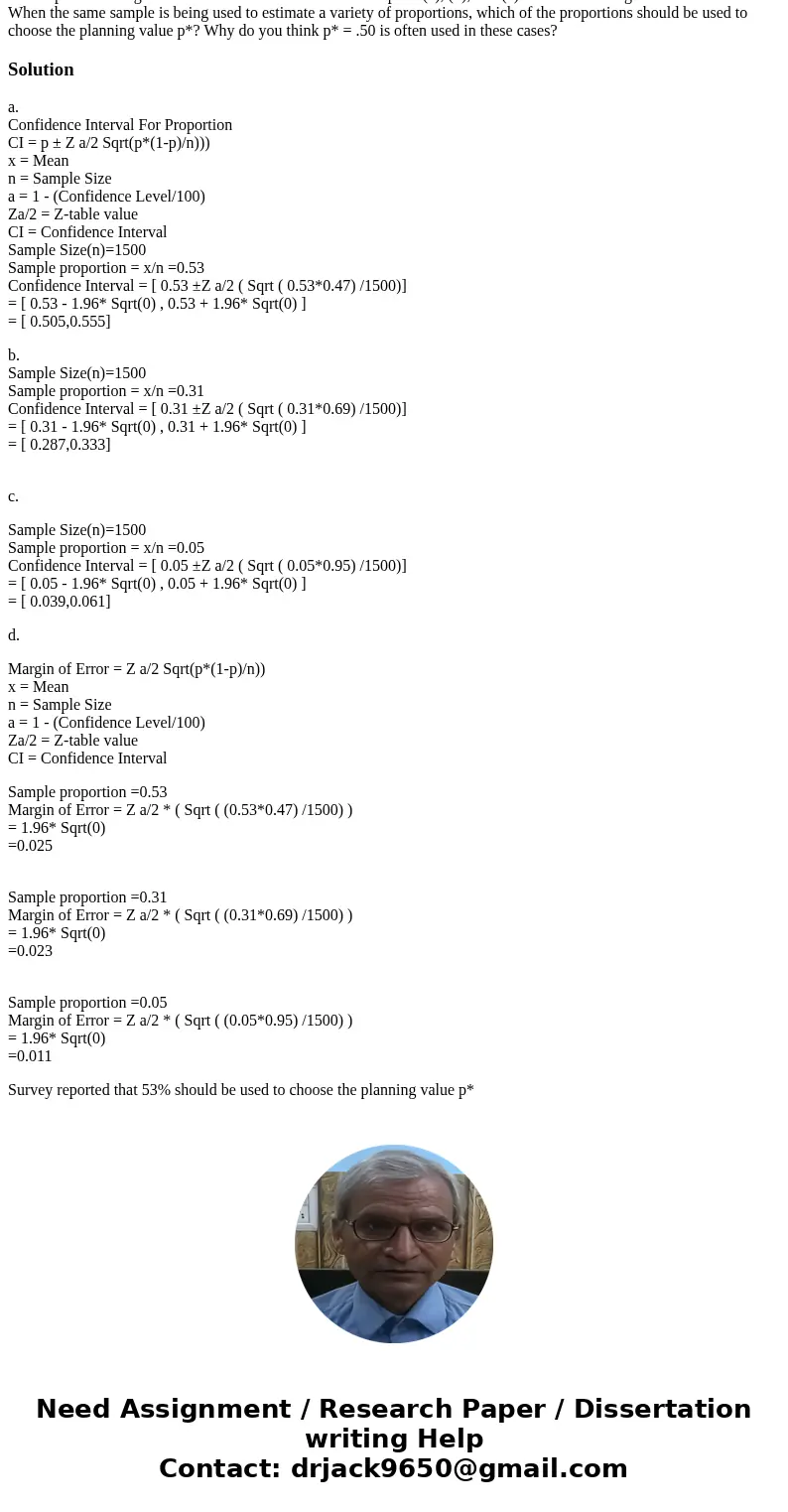A Phoenix Wealth ManagementHarris Interactive survey of 1500
A Phoenix Wealth Management/Harris Interactive survey of 1500 individuals with net worth of $1 million or more provided a variety of statistics on wealthy people (BusinessWeek, September 22, 2003). The previous three-year period had been bad for the stock market, which motivated some of the questions asked.
a. The survey reported that 53% of the respondents lost 25% or more of their portfolio value over the past three years. Develop a 95% confidence interval for the proportion of wealthy people who lost 25% or more of their portfolio value over the past three years. (to 3 decimals) Enter your answer using parentheses and a comma, in the form (n1,n2).
b. The survey reported that 31% of the respondents feel they have to save more for retirement to make up for what they lost. Develop a 95% confidence interval for the population proportion (to 3 decimals) Enter your answer using parentheses and a comma, in the form (n1,n2). )
c. Five percent of the respondents gave $25,000 or more to charity over the previous year. Develop a 95% confidence interval for the proportion who gave $25,000 or more to charity. (to 3 decimals) Enter your answer using parentheses and a comma, in the form (n1,n2).
d. Compare the margin of error for the interval estimates in parts (a), (b), and (c). How is the margin of error related to ? When the same sample is being used to estimate a variety of proportions, which of the proportions should be used to choose the planning value p*? Why do you think p* = .50 is often used in these cases?
Solution
a.
Confidence Interval For Proportion
CI = p ± Z a/2 Sqrt(p*(1-p)/n)))
x = Mean
n = Sample Size
a = 1 - (Confidence Level/100)
Za/2 = Z-table value
CI = Confidence Interval
Sample Size(n)=1500
Sample proportion = x/n =0.53
Confidence Interval = [ 0.53 ±Z a/2 ( Sqrt ( 0.53*0.47) /1500)]
= [ 0.53 - 1.96* Sqrt(0) , 0.53 + 1.96* Sqrt(0) ]
= [ 0.505,0.555]
b.
Sample Size(n)=1500
Sample proportion = x/n =0.31
Confidence Interval = [ 0.31 ±Z a/2 ( Sqrt ( 0.31*0.69) /1500)]
= [ 0.31 - 1.96* Sqrt(0) , 0.31 + 1.96* Sqrt(0) ]
= [ 0.287,0.333]
c.
Sample Size(n)=1500
Sample proportion = x/n =0.05
Confidence Interval = [ 0.05 ±Z a/2 ( Sqrt ( 0.05*0.95) /1500)]
= [ 0.05 - 1.96* Sqrt(0) , 0.05 + 1.96* Sqrt(0) ]
= [ 0.039,0.061]
d.
Margin of Error = Z a/2 Sqrt(p*(1-p)/n))
x = Mean
n = Sample Size
a = 1 - (Confidence Level/100)
Za/2 = Z-table value
CI = Confidence Interval
Sample proportion =0.53
Margin of Error = Z a/2 * ( Sqrt ( (0.53*0.47) /1500) )
= 1.96* Sqrt(0)
=0.025
Sample proportion =0.31
Margin of Error = Z a/2 * ( Sqrt ( (0.31*0.69) /1500) )
= 1.96* Sqrt(0)
=0.023
Sample proportion =0.05
Margin of Error = Z a/2 * ( Sqrt ( (0.05*0.95) /1500) )
= 1.96* Sqrt(0)
=0.011
Survey reported that 53% should be used to choose the planning value p*


 Homework Sourse
Homework Sourse